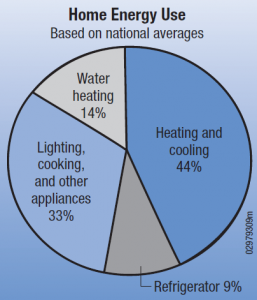
Source: http://www.windpoweringamerica.gov/pdfs/small_wind/small_wind_guide.pdf
Inspecting the figure above, it is shown that heating and cooling is the most dominant load in home energy use. In other words, if one were to use a wind turbine to power their heating and cooling in its entirety, then that consumer would save 44% on their energy bill! In addition to a wind turbine, if a photo-voltaic system is used to supply the demand used by the water heater, the consumer saves an additional 14% on their energy bill!
- Wind Turbine (simple) Calculations
Keeping it simple, estimate that a home uses 1000kWh/month on average at $0.10/kWh will result in a $100 bill each month. Using the figure above, the user spends $44/month on heating and cooling, $33/month on lighting, etc.
If the consumer wants to size a wind turbine to supply all his heating and cooling, this means the consumer’s turbine would need to supply 440kWh/month. Using 730.5h/month and dividing 440kWh/month by 730.5h/month yields ~600W. That is, the consumer would need a 600W turbine with an average wind speed of 10mph and no losses in the wiring, rectifier, and that 100% of the energy extracted from the wind was either stored or consumed by the user.
Many assumptions would made for these back-of-the-envelope calculations. These are only to be used to give a rough idea of what to expect from the power output of a wind turbine.
- Payback Calculations
Saving $44/month is nice, but what does it cost to produce these savings? How much is the over-head cost and how long will it take to pay it off?
Basic components for a home-use turbine:
- Wind Turbine (including generator) ~ $600 – Walmart
- Tower 30′ ~$800 – Menards
- Rectifier (for DC power) ~$0.00 (negligible)
- Inverter (2kW for AC power) ~$350 -donrowe.com
- Charge controller (to keep from over-charging batteries) ~$450 donrowe.com
- Batteries* ~$400 – techbatterysolutions.com
- Conclusion
If one is willing to pay for the overhead and is very patient, wind power generation is for you! Before you buy a wind turbine and accessories, one needs to consider [1]:
- your property has a good wind resource
- your home or business is located on at least one acre of land in a rural area
- your local zoning codes or covenants allow wind turbines
- your average electricity bills are $150 per month or more
- your property is in a remote location without easy access to utility lines
- you are comfortable with long-term investments
[1] http://www.windpoweringamerica.gov/pdfs/small_wind/small_wind_guide.pdf [Nov. 12, 2012]
– by Zachary Newell – Posted 11/12/2012 – newell1@illinois.edu
Note: the email provided will not be checked regularly after 12/22/2012

